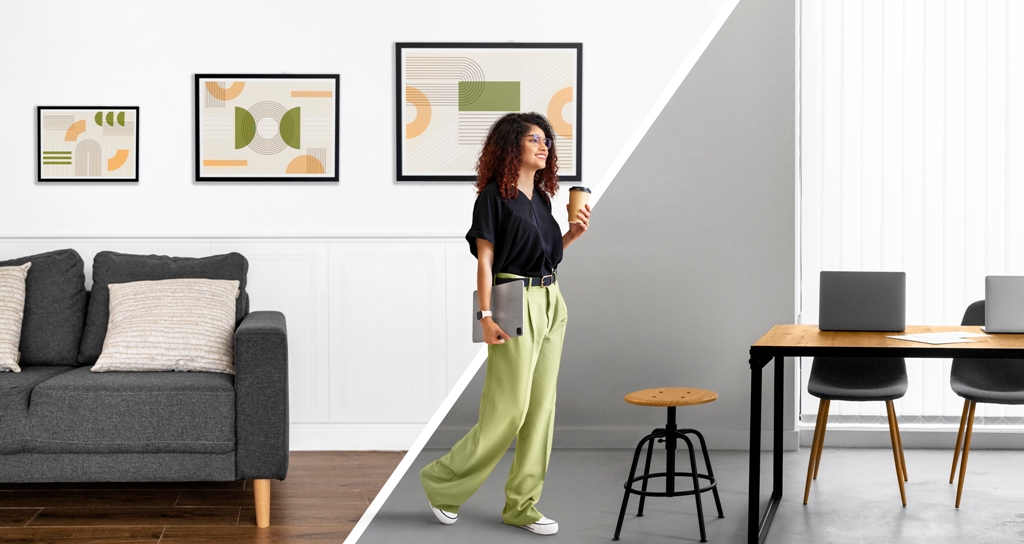
Visual contrast operates as the invisible conductor orchestrating every compelling interior space, transforming ordinary rooms into extraordinary experiences that captivate and energize. Far beyond simple color theory, contrast emerges through the deliberate juxtaposition of opposing elements that create tension, drama, and ultimate resolution within a single environment. This dynamic interplay between light and shadow, rough and smooth, large and small, creates the visual rhythm that prevents spaces from falling into monotonous uniformity.
The magic begins when designers abandon the safe path of matching everything perfectly. Instead, they embrace the electric energy that emerges when contradictory elements coexist within carefully orchestrated boundaries. A sleek modern sofa gains prominence when placed against weathered brick walls. Delicate crystal chandeliers become breathtaking focal points when suspended above industrial concrete floors. These unexpected partnerships create visual friction that demands attention while simultaneously achieving a sophisticated balance that feels both surprising and inevitable.
Textural Tensions That Transform Spaces
Surface variation provides one of the most accessible yet impactful methods for introducing visual contrast into any environment. The human eye craves textural diversity, unconsciously seeking the interplay between materials that offer different tactile experiences even when viewed from a distance. Polished marble countertops gain depth and character when paired with rough-hewn wooden beams overhead. Soft velvet upholstery becomes luxurious when contrasted against crisp linen curtains or nubby wool throws.
This textural dialogue extends beyond traditional material combinations to encompass the full spectrum of surface treatments available in contemporary design. Glossy lacquered furniture creates stunning visual impact when positioned against matte-painted walls, while heavily textured wallpapers provide dramatic backdrops for sleek, minimalist accessories. The key lies in maintaining enough similarity to create cohesion while ensuring sufficient difference to generate visual excitement.
Natural materials offer particularly rich opportunities for textural contrast. Stone surfaces bring earthiness and solidity that beautifully complements the organic irregularity of natural wood grains. Woven textiles introduce softness and flexibility that plays beautifully against the rigid geometry of metal fixtures and fittings. These material combinations create layered visual experiences that reward closer inspection while maintaining their impact from across the room.
Scale Dynamics and Proportional Play
Size relationships within interior spaces create another powerful avenue for generating visual interest through contrast. Oversized artwork commands attention and creates dramatic focal points, especially when displayed in rooms with otherwise modest furnishings. Conversely, collections of small objects gain collective impact when grouped together against expansive blank walls or oversized furniture pieces.
Mixing furniture scales creates dynamic visual hierarchies that guide the eye through spaces in intentional ways. A massive sectional sofa paired with delicate side tables creates an engaging size relationship that prevents the large piece from overwhelming the room while adding functional surface area without visual weight. Similarly, grouping furniture of varying heights creates undulating visual rhythms that break up monotonous horizontal lines.
Architectural elements offer permanent opportunities for scale contrast that influence every subsequent design decision. High ceilings paired with low, horizontal furniture emphasize verticality while creating intimate seating areas within grand spaces. Conversely, tall bookcases or floor-to-ceiling curtains can add vertical emphasis to rooms with standard ceiling heights, creating the illusion of greater spatial volume through strategic proportional manipulation.
Light and Shadow as Design Elements
Illumination patterns create some of the most dramatic yet subtle forms of visual contrast available to interior designers. The interplay between brightly lit areas and shadowed zones adds depth, mystery, and visual complexity that transforms flat spaces into three-dimensional experiences. Strategic lighting placement can emphasize textural contrasts, highlight architectural features, and create intimate zones within larger open spaces.
Natural light provides ever-changing contrast opportunities throughout the day as shadows shift and intensify across interior surfaces. Rooms positioned to capture dramatic morning or evening light can showcase this temporal contrast through careful selection of reflective or absorptive materials that respond differently to changing illumination conditions. Sheer curtains create soft, diffused lighting effects that contrast beautifully with sharply defined shadows cast by geometric furniture or architectural elements.
Artificial lighting systems offer precise control over contrast creation, allowing designers to craft specific moods and highlight particular design elements. Focused spotlights create pools of intense illumination that contrast dramatically with surrounding dimmer areas, while uplighting bounced off ceilings provides gentle ambient illumination that softens harsh shadows without eliminating them entirely.
Color Relationships Beyond the Obvious
While color contrast often defaults to discussions of complementary colors on the color wheel, sophisticated color relationships extend far beyond these basic principles. Monochromatic schemes gain depth and interest through value contrast—the relationship between light and dark tones within the same color family. A room decorated entirely in various shades of blue becomes visually compelling when deep navy anchors are balanced by pale sky tones and medium blues bridge the gap between extremes.

Temperature contrast offers another sophisticated approach to color relationships that creates visual interest without relying on high-contrast color combinations. Warm wood tones paired with cool gray stones create subtle but effective temperature contrast that adds depth without overwhelming the space. Similarly, mixing cool-toned metals like brushed steel with warm brass or copper creates metallic contrast that adds richness and complexity to color schemes.
Saturation levels provide additional opportunities for creating visual interest through color contrast. Highly saturated accent colors gain power and prominence when surrounded by more muted tones, while spaces decorated primarily in vibrant colors can benefit from neutral areas that provide visual rest and prevent sensory overload.
Pattern Mixing and Visual Rhythm
Successfully combining different patterns requires understanding how scale, color, and motif interact to create either harmony or chaos. Large-scale patterns paired with small-scale designs in similar color palettes create engaging contrast without visual conflict. Geometric patterns gain impact when balanced by organic, flowing designs that provide visual counterpoint to rigid mathematical precision.
Pattern contrast works most effectively when unified by consistent color relationships or when patterns share common elements while differing in scale or orientation. Stripes paired with florals create classic contrast combinations, while plaids mixed with polka dots offer more playful pattern relationships that work particularly well in casual or eclectic design schemes.
The distribution of patterns throughout a space affects the overall visual impact significantly. Concentrating bold patterns in specific areas while maintaining quieter zones prevents pattern overload while ensuring that contrasting designs have sufficient visual space to be appreciated individually while contributing to the overall design narrative.
Functional Elements as Contrast Creators
Everyday functional items often provide unexpected opportunities for introducing visual contrast into interior spaces. The Clarendon Cast Iron Radiator demonstrates how utilitarian heating elements can serve dual purposes, providing necessary climate control while contributing significant visual weight and material contrast that enhances rather than detracts from overall design schemes. These substantial metal elements introduce industrial character that contrasts beautifully with softer furnishing materials.
Kitchen appliances, bathroom fixtures, and storage solutions all offer similar opportunities for functional contrast integration. Sleek modern appliances create striking contrasts when installed in traditionally detailed cabinetry, while vintage-inspired fixtures add character and visual interest to contemporary minimalist spaces.
Balancing Act: When Contrast Becomes Chaos
Successful contrast application requires restraint and careful editing to prevent visual overload. Too many contrasting elements competing for attention creates chaos rather than compelling design. The most effective contrast strategies focus on one or two primary opposition relationships while supporting these main contrasts with subtler variations that add depth without confusion.
Establishing a visual hierarchy helps organize contrasting elements into coherent design narratives. Identifying the most important contrast relationship within each space allows other elements to support rather than compete with the primary visual story, creating layered complexity that rewards extended viewing while maintaining overall coherence.
Conclusion
Visual contrast transforms ordinary spaces into extraordinary environments through the thoughtful orchestration of opposing elements that create tension, resolution, and endless visual fascination. By understanding how texture, scale, light, color, pattern, and function can work together or against each other, designers create spaces that engage viewers on multiple levels while maintaining the sophisticated balance that distinguishes memorable interiors from forgettable ones. The power of contrast lies not in creating jarring opposition but in finding the perfect tension between elements that ultimately complement each other while maintaining their individual character and impact.

